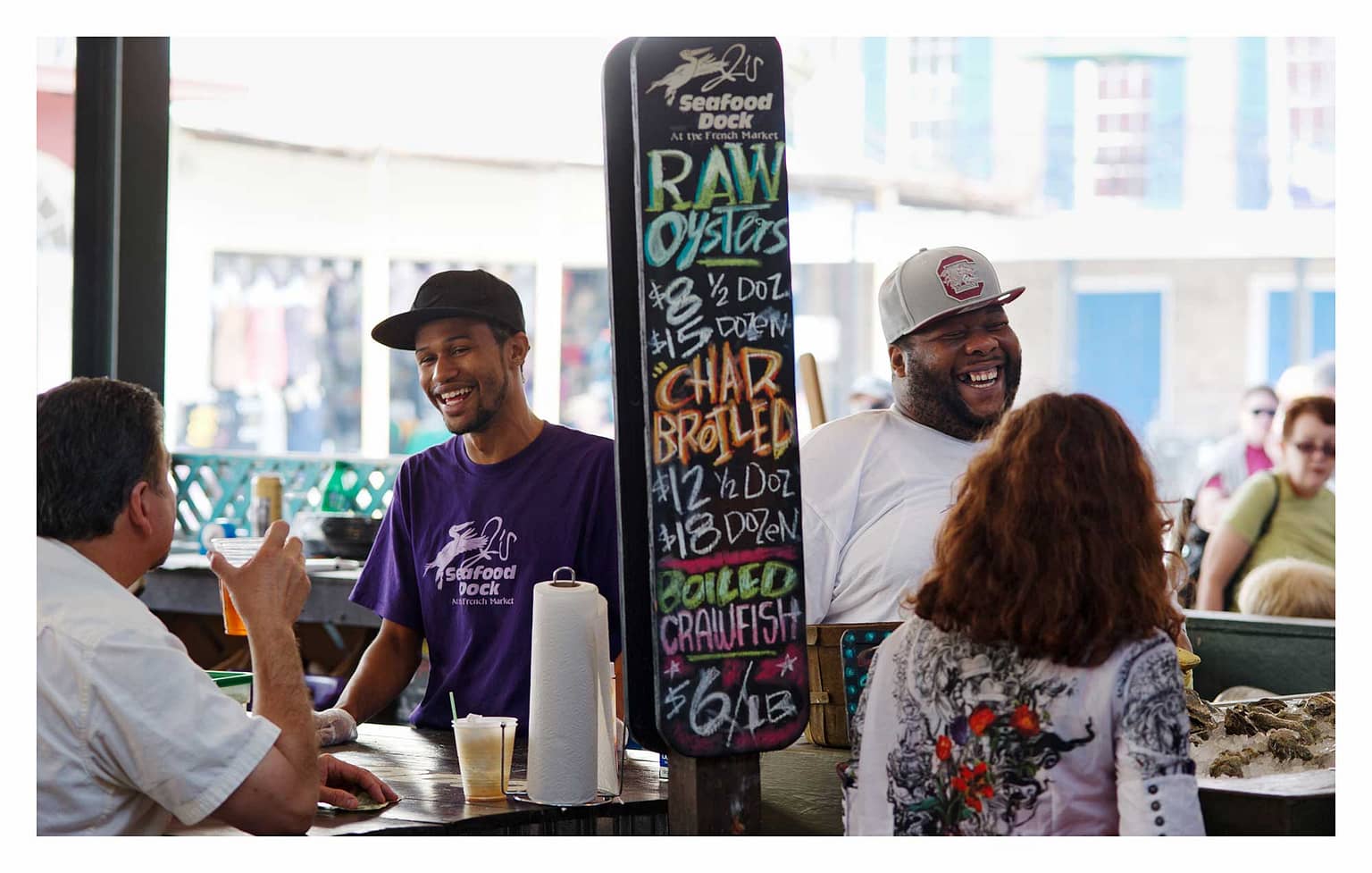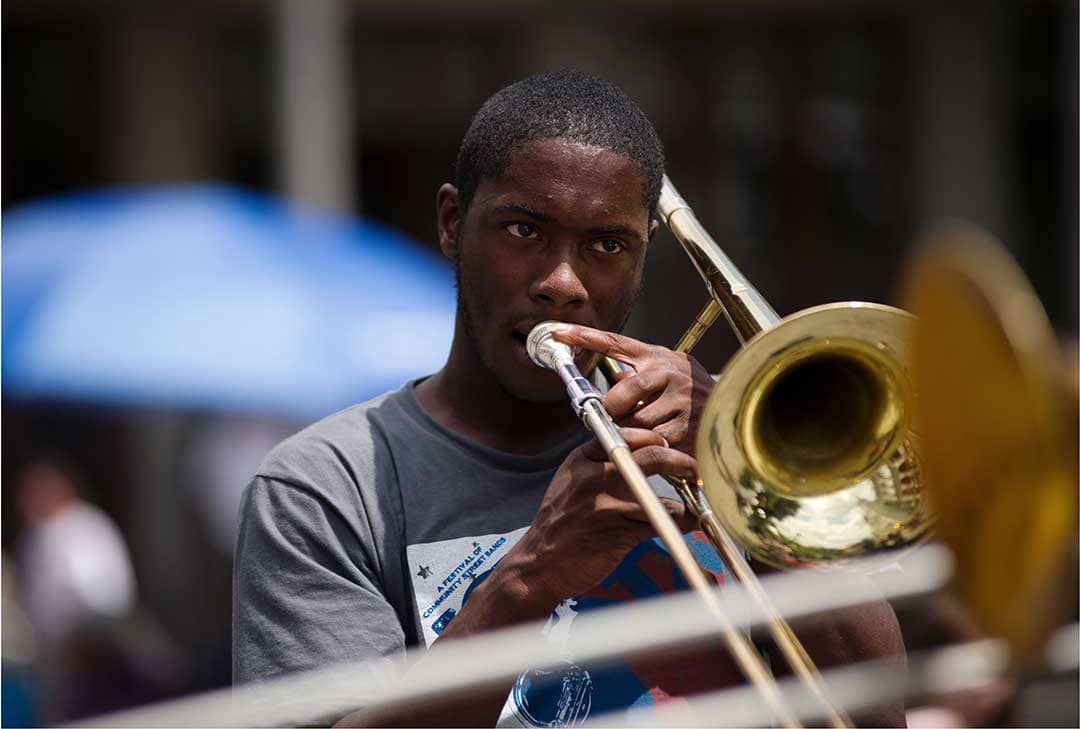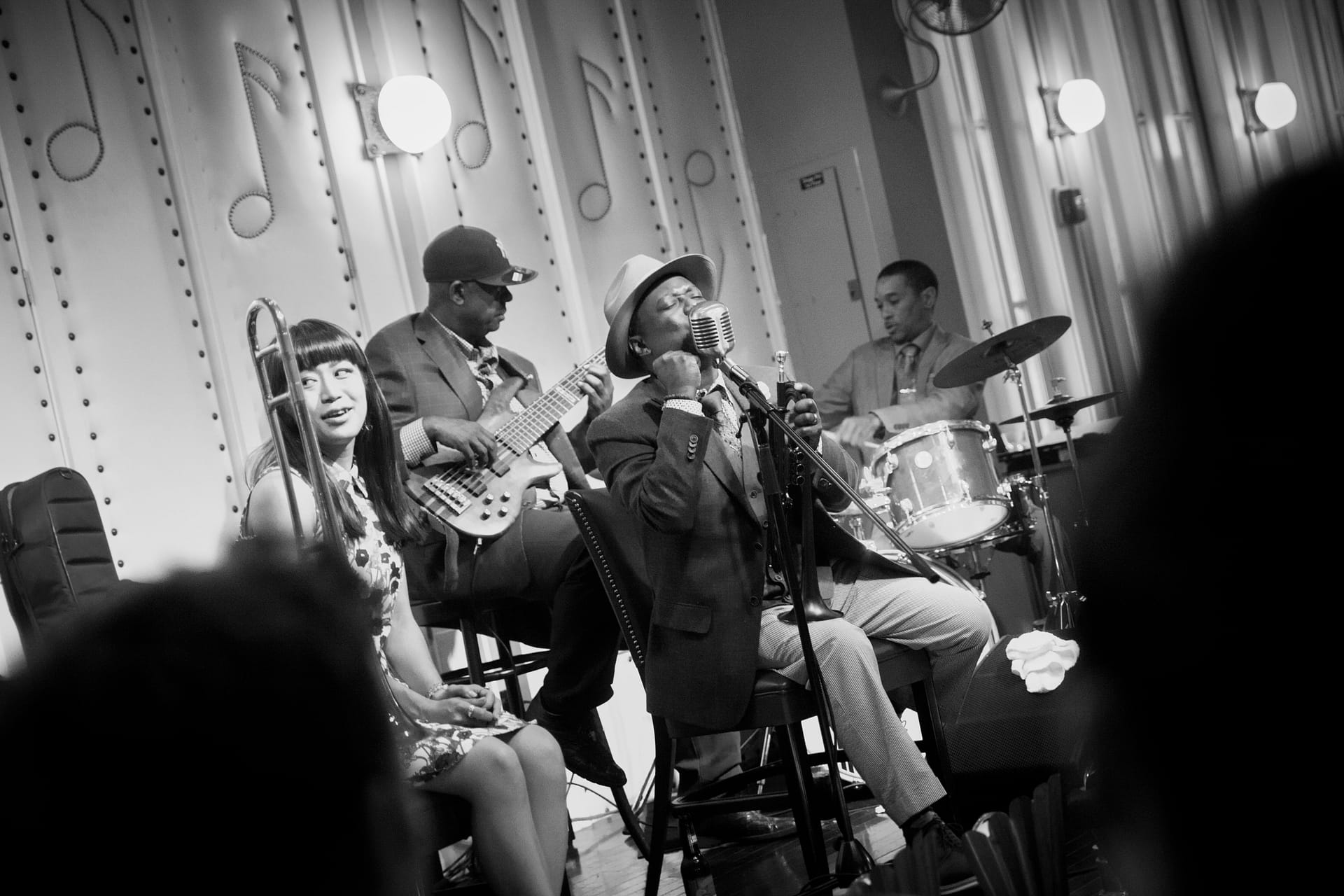

NEW ORLEANS | a love affair
Love, food, music. The three ingredients in the mix that make The Big Easy the obvious destination for international lovers.
Words by Jonas Henningsson. Photos by Anders Bergersen, Jonas Henningsson and Jonas Larsson

An inquisitive piano hook makes its way through the room, and the lady next to us suddenly breaks off from telling us about the city she loves. Soon, the drums brush into action, a mellow bassline kicks in, and the trumpet takes the lead. The murmurs at the tables die down, and the clanging sound of cutlery in use goes away. And then, a powerful, captivating voice takes over the Little Gem Saloon. Kermit Ruffins has the audience spellbound. Indeed, they are all in the palm of his hand, listening intently to his story. The woman at our table smiles blissfully, holding her breath. The band, the BBQ Swingers, start to pick up steam. Soon, the pianist takes over, firing the crowd up with his equilibristic explorations of the keyboard. Next, the drummer, not one to be outshone, takes his turn as the cheers from the crowd grow louder. When he’s finished, an avalanche of applause follows, before Kermit draws another breath and continues.This scene is acted out every day, or perhaps, more accurately, every evening and night in New Orleans. There is music everywhere in the city, music overflowing into the streets. Music that makes the nights live forever. This city would survive no better without music than a human body would without a heart. Or, rather: Music is the beating heart of New Orleans.We leave Little Gem as the final notes of Kermit’s second set ring out. Inhale the humid, lukewarm evening air, and follow the echoes of notes through the French Quarter. Our mood picks up even more when we see the throngs of people that are milling around on the street. In this city, life is lived out on the streets. They are where meetings, fights, and love all happen, in a way we’ve not experienced anywhere else in this vast country. We slip through the bustle of Bourbon Street, cutting a path through the crowd, and stop to catch our breath on the less busy Chartres Street.


There really is no other city like New Orleans, or NOLA, in the USA. It leads a life all of its own down in the Deep South, right by one of the last bends the mighty Mississippi makes on its way across the country to the point where it flows into the Mexican Gulf. The colorful past of New Orleans is also a story about the USA, A story of colonialization, French influence, the defeat of the British, and the impact that Haiti and other Latin American countries have had on the country. All these things converge in a city that defies imitation; a simmering, frothing melting pot of cultures, displaying its heritage in its music, in its culinary offerings, in its art scene, and in an attitude that seems entirely separate from that of the rest of the country. In NOLA, people from all parts of America, and the whole world, come together to do their thing. As mentioned, NOLA is unique among the cities of the USA, or of the world, for that matter. And we simply adore it.
Cajun, Creole, and Colonization
The music has made us hungry, and we sneak into the Napoleon House to order Jambalaya, the dish that sums up many the strands that run through Nola’s culinary history. Cajun is a robust and direct cuisine, created by French Canadians who brought their own culture with them on their migration along the Mississippi, across the continent, and all the way down to the South. Creole is the urbane, cosmopolitan food culture of Nola. It blends French, African, and Spanish flavors with local produce.

The word Creole denotes a person descended from the French and Spanish settlers of colonial Louisiana and New Orleans, who constituted the city’s ruling classes in the 18th century. Creole Jambalaya originated in the French Quarter, the result of the Spanish attempting to recreate their paella in the New World, where saffron was an expensive import, and hard to come by. Instead, they used tomatoes as a substitute for saffron. In time, the French grew more influential in New Orleans, and the use of spices from the Caribbean transformed the paella of the Old World into a unique dish. In present-day Louisiana, the dish has evolved in a variety of directions. Creole Jambalaya, or “Red Jambalaya”, is mainly found in and around New Orleans, where it is simply referred to as Jambalaya. Creole Jambalaya contains tomatoes, but Cajun Jambalaya does not. Cajun Jambalaya comes from the rural marshlands of Louisiana, where there was an abundance of crawfish, shrimp, oysters, alligator, duck, turtle, wild boar, and other wildlife. Any combination of meat can be used to make Jambalaya, including chicken and turkey. Cajun Jambalaya is known as “Brown Jambalaya” in the New Orleans area, but the Cajuns simply call it Jambalaya. Cajun Jambalaya has a smokier, spicier flavor than its Creole cousin. The French Creoles were the ones who introduced the Cajuns to Jambalaya.
Beachbum Berry
If music is the heart of the city, its stomach and brain are food and drink, respectively. Somebody who knows all about this is Jeff ‘Beachbum’ Berry.- This town takes food and drink very seriously, as seriously as any company town would take its business. It’s just like in Washington DC, where the most widely read journalists would be the political commentators, and in New York, where it would be the stock analysts, or in Los Angeles, the movie reviews. Here, restaurant reviews are as widely and hotly discussed as movie reviews are in Hollywood.We’re sitting at Latitude 29, Jeff’s very own tiki bar, which he has established in the Bienville House Hotel, sipping a Pearl Diver and talking about the New Orleans-born pioneer “Donn Beach”, who opened the first tiki bar, Don the Beachcomber, in 1934. The culture flourished in the decades that followed. Now, tiki culture is back in fashion, unlike the long years during the 20th century when it was nowhere to be seen. Berry refers to this time as the “Dark Ages of the Cocktail,” which spanned from the 1970s up through the late 1990s.


But at the turn of the millennium, things changed.-You had books and magazine articles, and bartenders who were going back to the way things used to be done, and a sense of craft was instilled again.
– Tiki cocktails were the first craft cocktails, before the term even existed. These drinks were very complicated and expensive to make, and when the golden age ended, all the bartenders who knew how to make them were scattered to the four winds. There was no demand for them anymore, and the recipes had never been published, because the drinks were valuable business secrets, and you didn’t want your competition to find out what was in them.
As Jeff speaks, we hear the rhythmic clatter of the bartender shaking a new cocktail behind him. If Jazz is the first soundtrack we’ve come to associate with NOLA, this is the second. We try a Mai Tai and a Zombie.
The fact that Jeff and his wife Annene Kaye ended up in New Orleans came down to a sense of belonging, emotions, and love.
– Everybody we met was very warm, all lovely people. So we thought, this is it. We’re moving here!
Jeff has done more for tiki culture than anybody else. He’s spent the last twenty years researching, studying, and tracking down the old recipes, and working tirelessly to perfect the art of mixing a tiki cocktail.
– The recipes were never written down. So, it was basically a matter of finding a ninety-year-old bartender who was willing to tell me what was in the drink… Often, the bartenders had already died, and it was their wife or daughters or sons who had a shoebox full of memorabilia. In that box, there might be a recipe book the size of a shirt pocket notebook. The bartenders kept their recipes closely under wraps. Don the Beachcomber wrote his recipes in code because so many people took his recipes and went and opened their own bars.
– It took me a long time to break the code. It was my hobby, I was doing this unprofessionally, working in isolation. I published the recipes in a little booklet for other tiki nerds, and then one thing lead to another, and soon there were five books. Then the tiki revival happened, and all of a sudden, these recipes were spreading all over the world.
Now, there were tiki bars everywhere. Jeff’s evangelizing had born fruit. The moment for him to take the next step had arrived.
– “It was time to stop just writing about drinks and start serving them!” he laughs.

Frenchmen Street and the Nola Night
We leave Beachbum Berry and continue our wandering through the city. While we were lost in tiki land, the sky shifted from bright cobalt blue to pitch black. Music is spilling out onto the streets from the restaurants and bars of the city. On Frenchmen Street, we catch a handful of rollicking concerts in an equal number of establishments. The Spotted Cat, d.b.a, Three Muses. Jazz, blues, folk, skiffle. More jazz! In every place we visit, we make friends for life. In every joint, we become more convinced that this is where we really ought to live. We remember what Jeff said about the people here.

If you don’t dance in New Orleans, then you probably don’t dance at all.
At the Three Muses, we meet Sarah Candler. She wants to show us a bird’s-eye view of the city, and we’re soon stretched out on her roof terrace in Marigny, taking in the full moon that has parked itself above the Mississippi river. Sarah brings out her guitar; she wants to play us some new songs. We hear a freight train go by in the distance, and a boat floats through the light of dawn, heading right out across the water. It rounds the sharp turn in the river by Algiers Point, and continues off out of sight, and we soon lose ourselves in Sarah’s beautiful tune. Before she has finished playing, the first weary rays of daylight reach us. They reflect off the fiery red of the bricks and glisten on the surface of the golden-brown waters of the Mississippi. Literal early birds greet the sun in a lively dance across the sky. The music down on Marigny Street has stopped. Nola takes a deep breath and waits for the next day, the next evening. The next night. And we fall head over heels for the city all over again.









